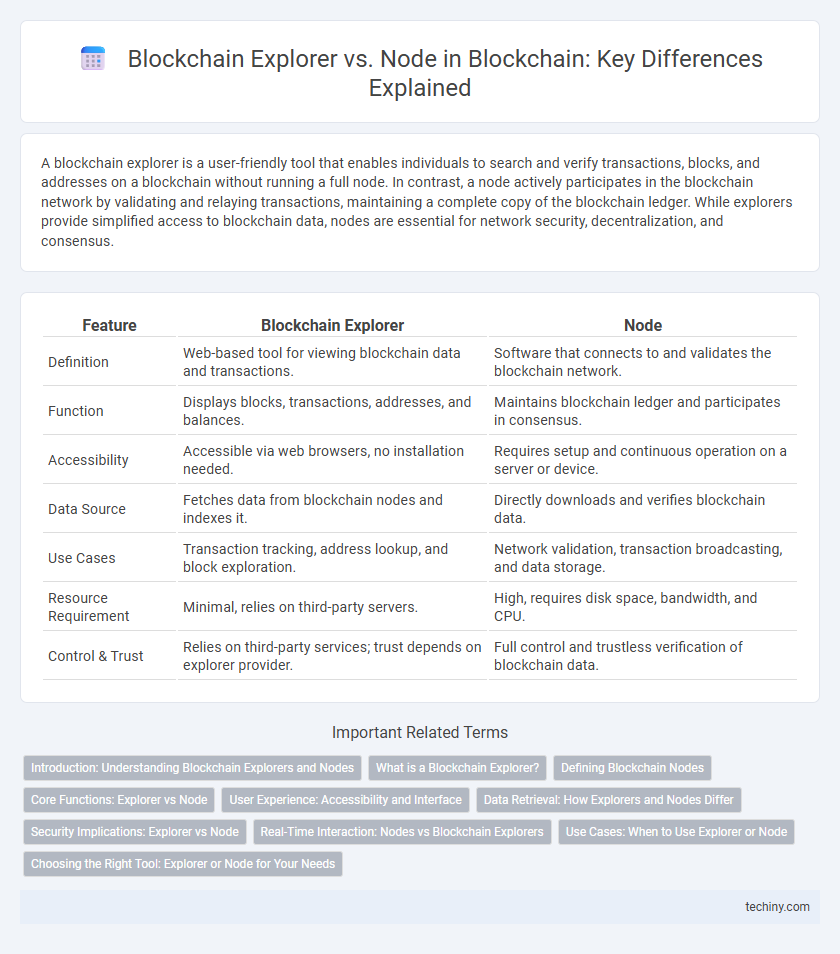A blockchain explorer is a user-friendly tool that enables individuals to search and verify transactions, blocks, and addresses on a blockchain without running a full node. In contrast, a node actively participates in the blockchain network by validating and relaying transactions, maintaining a complete copy of the blockchain ledger. While explorers provide simplified access to blockchain data, nodes are essential for network security, decentralization, and consensus.
Table of Comparison
| Feature | Blockchain Explorer | Node |
|---|---|---|
| Definition | Web-based tool for viewing blockchain data and transactions. | Software that connects to and validates the blockchain network. |
| Function | Displays blocks, transactions, addresses, and balances. | Maintains blockchain ledger and participates in consensus. |
| Accessibility | Accessible via web browsers, no installation needed. | Requires setup and continuous operation on a server or device. |
| Data Source | Fetches data from blockchain nodes and indexes it. | Directly downloads and verifies blockchain data. |
| Use Cases | Transaction tracking, address lookup, and block exploration. | Network validation, transaction broadcasting, and data storage. |
| Resource Requirement | Minimal, relies on third-party servers. | High, requires disk space, bandwidth, and CPU. |
| Control & Trust | Relies on third-party services; trust depends on explorer provider. | Full control and trustless verification of blockchain data. |
Introduction: Understanding Blockchain Explorers and Nodes
Blockchain explorers provide user-friendly interfaces to search and analyze blockchain transactions, blocks, and addresses in real-time, enabling transparent access to decentralized ledger data. Nodes operate as the backbone of blockchain networks by validating, storing, and propagating transaction data, ensuring network security and consensus integrity. While nodes maintain the decentralized infrastructure, explorers translate complex blockchain data into accessible visual insights for users.
What is a Blockchain Explorer?
A blockchain explorer is a web-based tool that allows users to navigate and search blockchain data such as transaction histories, block details, and wallet addresses. It indexes and displays real-time information from a blockchain network, enabling transparency and verification without the need to run a full node. Unlike a node, which participates in network validation and consensus, a blockchain explorer focuses solely on data retrieval and visualization.
Defining Blockchain Nodes
Blockchain nodes are individual devices running software that maintain a copy of the blockchain ledger and validate transactions, ensuring network decentralization and security. Nodes directly interact with the blockchain protocol, broadcasting data and verifying blocks, whereas blockchain explorers serve as web interfaces to access and visualize this blockchain data. Understanding nodes as the fundamental infrastructure behind blockchain operation highlights their critical role in sustaining decentralized consensus and data integrity.
Core Functions: Explorer vs Node
Blockchain explorers provide a user-friendly interface to browse and search blockchain transactions, blocks, and addresses, enabling easy access to data without running a full node. In contrast, nodes are integral to the blockchain network's operation, validating transactions and maintaining the distributed ledger by storing a complete or partial copy of the blockchain. While explorers serve as analytical tools for transparency and data retrieval, nodes perform the core functions of consensus, data propagation, and network security.
User Experience: Accessibility and Interface
Blockchain explorers provide an intuitive, user-friendly interface that simplifies transaction tracking and blockchain data visualization compared to the more technical and resource-intensive node operation. Explorers offer real-time search features, graphical dashboards, and accessible insights catering to both novices and experts, enhancing overall user experience. Nodes demand command-line proficiency and substantial hardware, limiting their accessibility but enabling deeper network interaction and validation capabilities.
Data Retrieval: How Explorers and Nodes Differ
Blockchain explorers provide user-friendly interfaces that allow quick access to transaction histories, block details, and addresses by indexing and organizing blockchain data, while nodes maintain the entire blockchain ledger and validate transactions directly from the network. Explorers rely on nodes for raw data but optimize retrieval and query speed through databases and APIs, enabling efficient search and visual representation. Nodes prioritize network security and data accuracy by verifying and propagating transactions, offering authoritative but less accessible data compared to the streamlined experience of explorers.
Security Implications: Explorer vs Node
Blockchain explorers provide a user-friendly interface to track transactions and block data but rely on third-party servers, exposing users to potential data manipulation or privacy risks. Running a full node enhances security by independently verifying transactions and blocks, ensuring trustless validation without dependence on external sources. Nodes also help maintain network integrity by directly participating in consensus mechanisms, reducing vulnerabilities associated with centralized explorer services.
Real-Time Interaction: Nodes vs Blockchain Explorers
Blockchain nodes enable real-time interaction by directly verifying, validating, and relaying transactions within the network, ensuring up-to-the-second data accuracy and consensus participation. Blockchain explorers provide user-friendly interfaces that display real-time blockchain data by querying nodes, offering visibility into transaction status, block confirmations, and address activity without requiring the full network participation. While nodes serve as the backbone of blockchain infrastructure with active network engagement, explorers act as analytical tools for real-time blockchain insight and transparency.
Use Cases: When to Use Explorer or Node
Blockchain explorers provide a user-friendly interface for tracking transactions, blocks, and addresses, making them ideal for quick verification, transparency, and public data access. Nodes are essential for developers and network participants who require direct interaction with the blockchain, enabling transaction propagation, smart contract execution, and maintaining consensus. Use blockchain explorers for monitoring and auditing purposes, while nodes are necessary for full network participation, validation, and running decentralized applications.
Choosing the Right Tool: Explorer or Node for Your Needs
Blockchain explorers provide an intuitive interface for tracking transactions, blocks, and addresses, enabling quick access to on-chain data without running a full node. Nodes participate directly in the network by validating transactions and maintaining the blockchain ledger, offering deeper control and security but requiring significant storage and processing power. Selecting between a blockchain explorer and a node depends on whether you prioritize ease of use and data accessibility or full network participation and trustlessness for your blockchain needs.
Blockchain explorer vs Node Infographic

 techiny.com
techiny.com